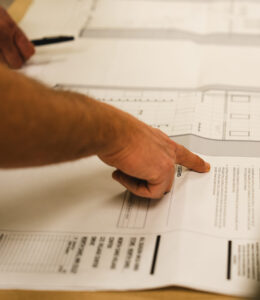Minnesota’s winters are legendary for their bone-chilling temperatures, heavy snowfalls, and icy winds. While the snow-covered landscapes may create a picturesque scene, they also present significant challenges for commercial construction projects in the region. As the chilly weather settles in, construction teams face unique obstacles that demand specialized expertise and strategic planning.
In this article, we explore the essential strategies for conquering the winter construction frontier in Minnesota and why Randahl Construction stands out as the premier commercial construction company in the Twin Cities throughout the colder months and all year round.
Understanding the Winter Construction Landscape in Minnesota
Winter in Minnesota is not for the faint of heart, and commercial construction contractors in the Twin Cities must be prepared to tackle many challenges. Sub-zero temperatures, frozen ground, and unpredictable snowstorms can disrupt construction schedules and impact project timelines. However, with the strategic planning, construction can proceed smoothly, efficiently, and with minimal delays.
Why Winter Construction Makes Sense
While the idea of starting a construction project in the heart of a Minnesota winter may seem counterintuitive, there are compelling reasons why undertaking commercial construction during this season makes perfect sense. Let’s take a look at the advantages of winter building:
Off-Peak Construction Season
Winter is traditionally considered the off-peak season for commercial construction in Minnesota. Many projects experience a slowdown during these colder months, creating a unique opportunity for those willing to seize it. This decreased demand often translates to the opportunity to secure more favorable pricing on materials and subcontractor services, leading to potential savings for clients who choose to build during the winter.
Faster Permit Approvals
The winter season often sees local permitting agencies with reduced workloads, resulting in quicker turnaround times for project approvals. The ability to swiftly navigate regulatory requirements contributes to faster project commencement and underscores the practicality of winter construction.
Majority of Construction Work Completed Indoors
One of the key advantages of winter building is that a significant portion of commercial construction work is completed indoors. This means that factors like freezing temperatures and snowfall have less impact on the construction process once initial building is completed.
Snow’s Limited Impact Compared to Rain
Contrary to the challenges of rain, snow generally has a less disruptive impact on construction projects. While heavy rainfall can lead to flooding, mud, and significant delays, well-managed snow can be easier to navigate. As a result, snowy construction sites can become accessible to our crews, allowing continued progress, even when snow blankets the regional landscape.
Building for the Future
Constructing during the winter months enables businesses to be proactive in their planning, ensuring that their facilities are ready for use in the subsequent seasons. Rather than waiting for the warmer months to break ground, forward-thinking companies recognize the long-term benefits of winter building.
Minnesota Winter Construction Practices
Cold-Weather Planning and Risk Mitigation
Before breaking ground, thorough cold-weather planning and risk assessments are crucial. This proactive approach identifies potential challenges associated with winter construction, such as frozen ground and extreme temperatures. Developing comprehensive strategies to mitigate these risks ensures that projects progress smoothly and stay on schedule despite adverse weather conditions.
Worker Safety Measures
Winter construction places additional demands on worker safety. Implementing strict safety measures, including proper insulation, heated break areas, and adherence to cold-weather clothing standards, safeguards the well-being of the construction team. Regular crew breaks and monitoring for signs of cold-related stress are integral to a robust safety protocol.
Snow and Ice Management Planning
The most successful commercial construction companies develop a comprehensive snow and ice management plan that addresses the unique challenges of winter weather. This includes protocols for snow removal, de-icing, and maintaining safe pathways for construction personnel and equipment. Efficient snow and ice management prevents delays and safety hazards, ensuring that construction activities proceed smoothly even during and immediately after snowfall.
Advanced Erosion Control Measures
Integrate advanced erosion control measures into the winter construction plan. Implementing innovative erosion control technologies, such as bioengineering solutions or erosion control fabrics, enhances the effectiveness of stabilization efforts. This ensures that vulnerable areas prone to erosion and sedimentation are adequately protected, promoting a more sustainable and environmentally responsible construction process.
Heated Material Storage
Consider investing in heated storage facilities to counter the challenges posed by frozen material stockpiles. Keeping materials at optimal temperatures can help prevent harmful changes to materials, ensuring that construction materials can be used effectively without compromising quality. Heated storage maintains the workability of materials and supports uniform distribution and compaction when needed.
Snow Removal from Critical Areas
Identify critical construction areas and implement a proactive snow removal strategy. Clearing snow from work zones, access points, and necessary equipment areas is essential for maintaining productivity. Construction activities can continue without interruptions caused by accumulated snow by designating snow removal priorities and using appropriate equipment as soon as it is safe to do so following a storm.
Cold-Weather Equipment Maintenance
Implement a rigorous cold-weather equipment maintenance program. Regularly inspect and maintain construction equipment to ensure optimal performance in freezing temperatures. This includes specialized attention to engines, hydraulics, and lubrication systems. Proper equipment maintenance reduces the risk of breakdowns, enhancing overall construction efficiency during the winter months.




